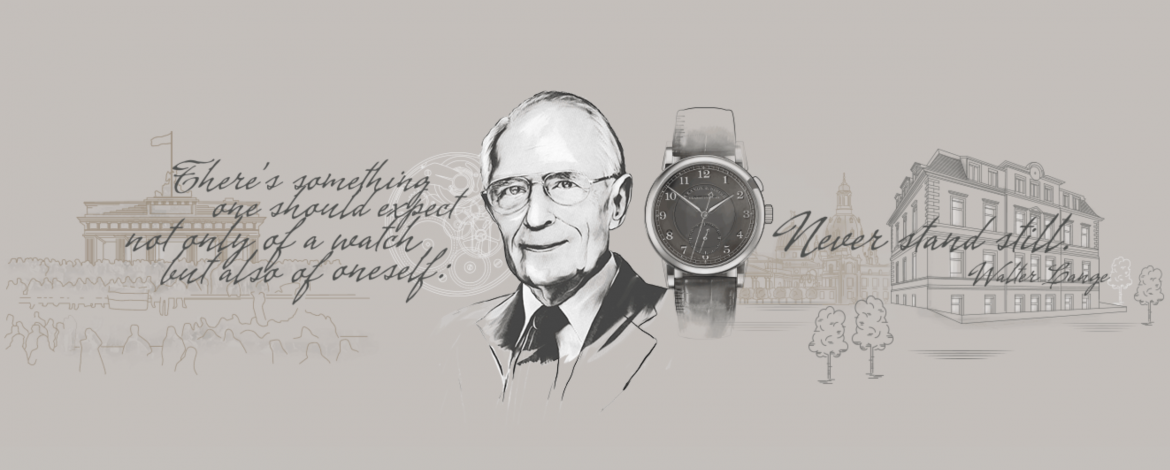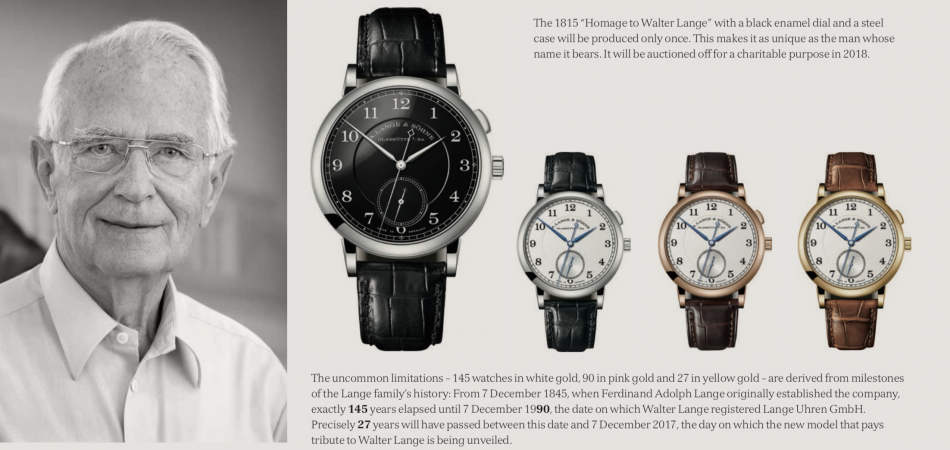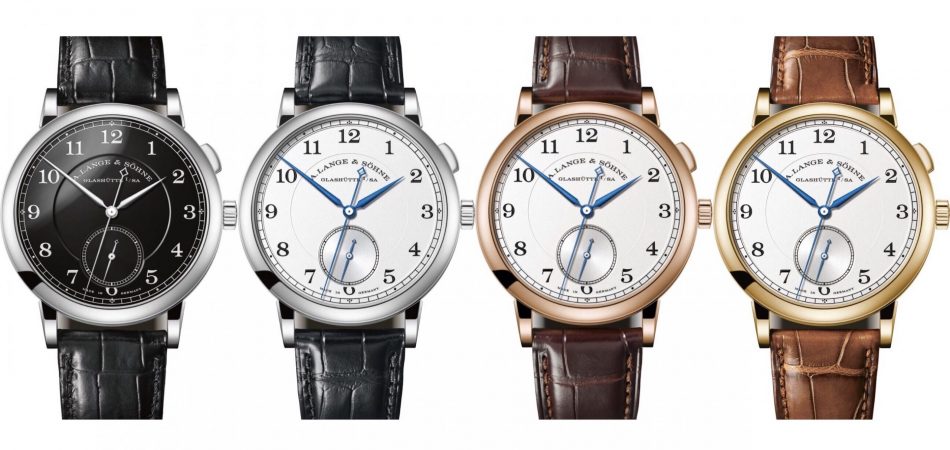“There’s something one should expect not only of a watch but also of oneself:
to never stand still”
– Walter Lange (29th July 1924 – 17th January 2017)
This would be one of the greatest, if not the best quote from a true watchmaker lineage, reflecting how one should live one’s life, moving forward everyday regardless of the tide’s depth or direction.
A. Lange & Söhne was founded in 1845 by Ferdinand Adolph Lange in the town of Glashütte, near Dresden, in the state of Saxony. It was under the leadership of Ferdinand, and his sons Emil and Richard, that Lange produced quality pocket watches during that period. In 1948, the post-war Soviet administration nationalised the company and all its property. Not until the fall of the Berlin Wall and German reunification that Walter Lange had a historic great opportunity; on 7 December 1990, in his home town of Glashütte which he had to leave in 1948 after his family was expropriated, Walter Lange brought back to life the inheritance left to him by his great grand-father, Ferdinand Lange.
Although Walter was then 66 years of age, true to his personal axiom in life, he kept moving forward and with his vision, determination and perfection, A. Lange & Söhne is today the true epitome of fine, exquisite and innovative precision timepieces.
It is fitting that in January 2018 at SIHH – the first anniversary of Walter Lange’s passing – that A. Lange & Söhne presented in tribute, the “1815 Homage to Walter Lange” stoppable jumping seconds hand.
“We had a lot of opportunity to make the greatest complicated watch as Walter’s homage watch, but we chose this jumping seconds watch, because he wanted it” explained Anthony de Haas, Product Development Director.
Anthony recalls that 5 to 6 times per year, he would meet Walter, and Walter would never fail to ask him to produce a timepiece with a jumping second hand because “my great-grandfather invented it and had a patent for it”, Walter would express to Anthony.
Anthony believes that a perfectly crafted mechanical timepiece should not look like a quartz movement on the dial, but “for Walter Lange, we did this jumping seconds”.
And an 1815 with jumping seconds likely corresponds to what Walter Lange would have deemed the perfect watch.
Let’s understand why, and how.
The 1815 collection is named with reference to the birth year of Ferdinand A. Lange. Characterised by traditional style elements: notably the blued hands, Arabic numerals and the railway-track minute scale, it is a handsome standout piece in Lange’s watchmaking heritage.
The jumping sweep seconds hand with the start/stop function was especially significant for Walter Lange as it dates back to the 150-year-old invention by his great-grandfather Ferdinand, in 1867. In fact, one of Germany’s first patents was granted to A. Lange & Söhne in 1877, for this enhanced design of a mechanism mounted on the three-quarter plate referred to as a “one-second movement with a jumping hand”.
The 1815 “Homage to Walter Lange”
Typically, mechanical timepieces can be recognised by their “creeping seconds” hand. Imagine the hand advancement from second to second in five to ten steps. With constant progression, to an untrained eye it may be harder to pinpoint the start and end of an event.
And then there is the horological complication – the “jumping seconds” that allows the exact smallest unit of time.
- The small seconds hand in the subsidiary dial at 6 o’clock maps the frequency of 21,600 semi-oscillations per hour by performing six small steps as it advances from marker to marker; while
- The blued sweep seconds hand performs precise jumps from second to second. It can be allowed to run continuously or immobilised if needed. A pusher at 2 o’clock starts and stops it. This is useful for heart rate measurements, for instance.
In the 1815 “Homage to Walter Lange”, the seconds jump is controlled according to the flirt-and-star principle, as was the case in the historic mechanism:
- After each full second, one of the six tips of the star liberates the tensioned lever arm (also known as the “flirt”). It then swiftly rotates by 360 degrees before it is stopped by the next tip.
- This motion sequence causes the seconds hand to advance by one marker.
- The ratchet wheel located above the three-quarter plate has a dual function: it stores the power needed for the seconds jump, while causing the sweep seconds hand to stop at the same time.
This puristic yet technically exciting complication impresses with its simplicity.
The newly developed movement has a special calibre designation: L1924. It refers to Walter Lange’s birth year.
Additionally, the first three digits of the reference number, 297, recall his date of birth, 29 July.
With a case diameter of 40.5 millimetres, the 1815 “Homage to Walter Lange” comes in three editions:
145 watches in white gold;
90 in pink gold; and
27 in yellow gold.
Why 145, 90 and 27? These numbers reference important milestones in the Lange family’s history .
From 7 December 1845, when Ferdinand Adolph Lange originally established the company, exactly 145 years elapsed until 7 December 1990, the date on which Walter Lange registered Lange Uhren GmbH.
And. Precisely 27 years will have passed between this date and 7 December 2017, the day on which the new model that pays tribute to Walter Lange is being unveiled.
1815 “Homage to Walter Lange” collection, images courtesy of A. Lange & Söhne
A limited edition one-piece-only in an enamel black dial and steel case is also produced as part of the 1815 “Homage to Walter Lange” collection, with the intention to auction it for charity. See the watch upclose here.
Wilhelm Schmid, Lange’s CEO alluded, during an interview conducted as part of a round table conversation hosted by television and radio presenter Piers Gibbon, why stainless steel was chosen as the material of choice for this unique piece:
“Because at A. Lange & Söhne, stainless steel is the most exotic material. This watch is one-of-a-kind and features a combination of the rarest materials. The number of Lange watches with a stainless-steel case can be counted on one hand. And a three-part enamel dial in black is the highest level of difficulty. On top of that, the watch will be equipped with a prototype movement, which makes it even more exclusive.”
The auction will be conducted by Geneva-based auction house Phillips in Association with Bacs & Russo at Geneva’s La Reserve hotel on 13 May 2018 between 6 and 9 p.m.
Proceeds will be donated to charity organisation Children Action Foundation, a charity committed to the physical and mental well-being of children and young people in need all over the world. 100% of the proceeds will go towards the aid projects.
Walter Lange would have been proud.





